Indo Lanka Accord marks 28 years
Posted on July 28th, 2015
By Dharman Wickremaratne
It will be 28 years on July 29, 2015 since India violated Sri Lanka’s air space, dropped food items, intimidated the UNP Government and President Jayewardene and forced him to sign the Indo-Lanka Accord.
By the middle of 1987 ‘Operation Liberation’ aimed at freeing Vadamarachchi in the North from Tamil separatists was moving ahead successfully. Directed by National Security Minister Lalith Athulathmudali nearly 8,000 troops were participating in the battle under the command of Brigadier Denzil Kobbekaduwa and Colonel Vijaya Wimalaratne. Brigadier G.H. de Silva was Overall Operations Commander. The Government was able to end the operation victoriously on June 3, 1987. It was the country’s biggest military operation since independence.
Dharman Wickremaratne
A telex message received on the previous night said that the Tamil Nadu Government were sending 25 boat loads of dhal (lentils) and other food items, foreign media personnel and 94 Red Cross monitors to the North. Nineteen boats which left Rameshwaram on June 3 entered Sri Lankan territorial waters on the same day at 6.00 p.m. Captain Suraj Munasinghe, Commanding Officer of the naval vessel ‘Edithara’ under instructions from Northern Naval Commander, Mohan Samarasekera stopped the Indian boats from moving forward. Minister Lalith Athulathmuali and Combined Operations Commander Cyril Ranatunga directed the naval operation by radio communication. After waiting at sea for three-and-a-half hours the boats turned back at 9.30 p.m. to return to India.
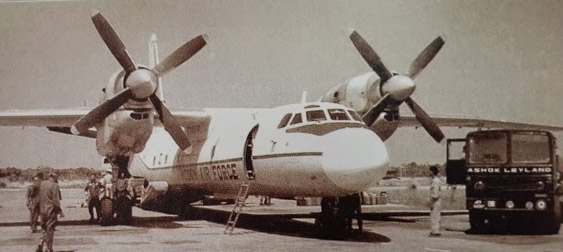 An Indian plane which dropped relief items including dhal (lentils).
An Indian plane which dropped relief items including dhal (lentils).
The Indian Government summoned Sri Lanka’s High Commissioner Bernard Tillekeratne to Indian Foreign Minstry in Delhi on June 4, 1987 at 2.30 p.m.and informed him that they had decided to air drop relief items to Jaffna. High Commissioner Tillekeratne conveyed the message to Foreign Minster A.C.S. Hameed in Colombo at 2.55 p.m. the same day.
After hearing the message President Jayawardene said that Sri Lanka would take no action against India’s violation of the island’s air space to drop relief supplies. At 3.55 p.m. the same day five Indian Air Force transport planes from their base in Bangalore flew towards Sri Lanka carrying 25 tons dry rations in boxes which they dropped by parachute over the Jaffna Peninsula at 5.00 p.m. India did this to force the Sri Lankan Government to stop the continuation of ‘Operation Liberation’ in Vadamarchchi to recapture Jaffna by mid-June. Consequently President Jayewardene announced that the operation would be stopped.
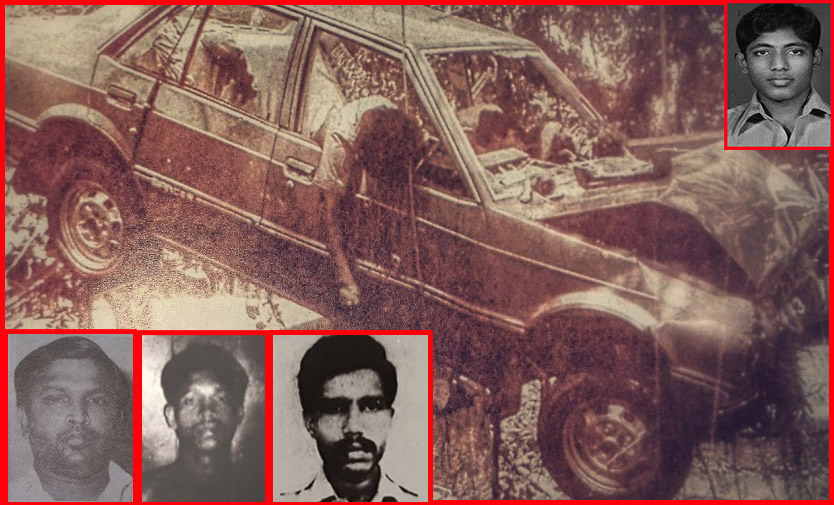 Ronnie, the founder President of the Deshapremi Student Movement who was shot dead while trying to escape with weapons after the JVP attack on the Katunayake 3. Air Force Base in protest against the Indo-Lanka Accord (above photo) and some of those who led the attack: Chief planner Saman Piyasiri, Shelton Rajapaksa and Air Force Technician Siripala.
Ronnie, the founder President of the Deshapremi Student Movement who was shot dead while trying to escape with weapons after the JVP attack on the Katunayake 3. Air Force Base in protest against the Indo-Lanka Accord (above photo) and some of those who led the attack: Chief planner Saman Piyasiri, Shelton Rajapaksa and Air Force Technician Siripala.
By this time the JVP had launched its second insurgency, claiming that it was the only force that could resist the (1) ‘treacherous’ UNP Government (2) armed Tamil separatism and (3) Indian aggression.
Three days after the Indian air-drop the JVP’s Armed Wing, the Deshapremi Janatha Vyapaaraya (Patriotic People’s Movement) stormed the Katunayake Air Force Base and the Kotalawala Defence Academy, Ratmalana and seized 14, T-56 assault rifles, 53 sub-machine guns, two light machine guns, six pistols and 3,300 rounds of ammunition. In the fighting that ensued two insurgents, Sumith Ranasinghe of Ragama and Jayewardenapura University Student Ronnie, were killed. The DJV took responsibility for the June 7, 1987 attack and announced that they would use the seized weapons against the Indian aggressor since the UNP regime did not use them against the enemy in defence of the motherland.
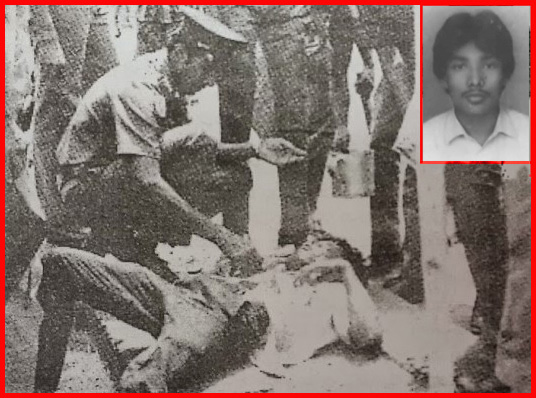 Moratuwa University Engineering Student Clifford Perera who was the first to die in the protest against the Indo-Lanka Accord, breathing his last (below) and his picture (above).
Moratuwa University Engineering Student Clifford Perera who was the first to die in the protest against the Indo-Lanka Accord, breathing his last (below) and his picture (above).
Daily demonstrations were held opposite the Indian High Commission and the High Commissioner’s official residence to protest against India’s violation of Sri Lankan airspace. High Commissioner J.N. Dixit informed Indian nationals in Sri Lanka to leave their homes and stay in hotels. In the meantime secret talks were underway with the participation of Dixit, ‘The Hindu’ Associate Editor N. Ram and Minister Gamini Dissanayake on signing an accord between the two countries. The Indian RAW (Research and Analysis Wing) agency was drawing up the necessary plans.
Accordingly, Indian High Commssion’s Second Secretary H.S. Puri left for Jaffna and met LTTE Chief V. Prabhakaran and other Tamil militant leaders. High Commissioner Dixit went to Madras and met leaders of Sri Lankan Tamil organisations. TULF Leaders insisted on merging the Northern and Eastern Provinces and setting up a separate Provincial Council to administer the region. Dixit conveyed their proposals to Indian Prime Minister Rajiv Gandhi in New Delhi. President Jayewardene summoned Government MPs on July 23,1987 and informed that he would work in cooperation with India to solve the crisis. The majority of MPs approved it.
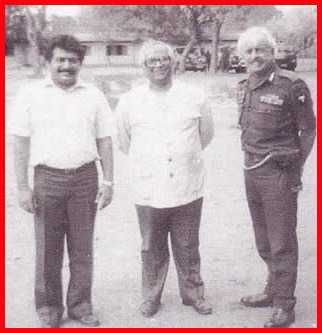 (From left to right) LTTE Chief Prabhakaran, Indian High Commissioner in Sri Lanka J.N. Dixit and Indian Army Major General Harikirat Singh in Jaffna after signing the Indo-Lanka Accord.
(From left to right) LTTE Chief Prabhakaran, Indian High Commissioner in Sri Lanka J.N. Dixit and Indian Army Major General Harikirat Singh in Jaffna after signing the Indo-Lanka Accord.
Two Indian military helicopters which landed in Jaffna from Madurai on July 24, 1987 took LTTE Chief Prabhakaran first to Madras and then to Delhi to meet PM Rajiv Gandhi. The purpose was get Prabhakaran to agree to a Indo-Lanka Accord to which TULF and other Tamil organisations had agreed. The talks were held at Ashok Hotel, Delhi, where Gandhi promised give more powers to the LTTE in a interim adminstration. The PM also agreed to pay its members Indian Rupees five million monthly until the new adminstration started functioning properly.
Sri Lankan Prime Minister Ranasinghe Premadasa was on an official tour of Japan at this time returned to the island on July 26, 1987, after hearing about the planned accord. He expressed his displeasure over President Jayawardene agreeing to it without informing him. There was a heated debate in Parliament over the proposed accord to which Opposition MPs Dinesh Gunawardena and Richard Pathirana vehemently opposed. The Government’s response was to postpone Parliamentary sessions by a majority of 65 votes to August 18.
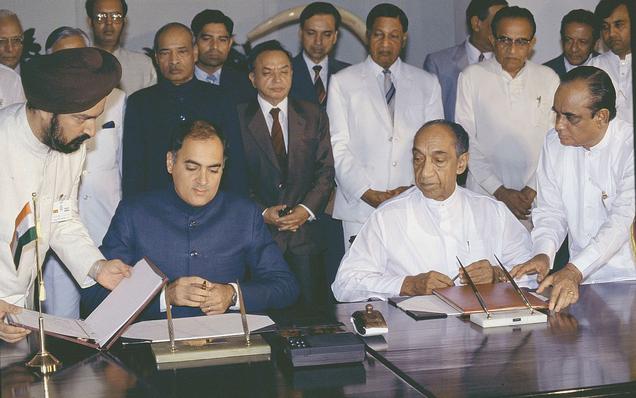 The signing of the Indo Lanka Accord: Seen here are Ministers A.C.S. Hameed, Gamini Dissanayake, Devanayagam, Hurulle, Presidential Secretary Menikdiwela, Indian Government Ministers Narasimha Rao, N.D. Thiwari and State Minister Natwar Singh
The signing of the Indo Lanka Accord: Seen here are Ministers A.C.S. Hameed, Gamini Dissanayake, Devanayagam, Hurulle, Presidential Secretary Menikdiwela, Indian Government Ministers Narasimha Rao, N.D. Thiwari and State Minister Natwar Singh
The UNP Government declared an island-wide curfew on the night of July 28, 1987, following a anti-accord protest campaign which began near the Bo-Tree junction Pettah earlier on the same day at 8.00 a.m. When this writer went there about 6.30 a.m. to report the event he saw JVP Politburo Members H.B. Herath and Gunaratne Wanasinghe, Central Commitee Members Gamini Wijegunasekera, Thangaraja and hundreds of other high level JVP activists already present.
By that morning red coloured posters, slogans and black flags appeared in Colombo and many other main cities expressing strong opposition to the UNP Government, the Indo-Lanka Accord and Tamil separatism.
Venerable Hedigalle Pannatissa, Ven. Maduluwawe Sobhitha, Ven. Muruttetuwe Ananda, Ven. Dr. Wilegoda Ariyadewa, MPs Dinesh Gunawardena and Prince Gunasekera were representing the Mawbima Surekeemay Vyaparaya (Motherland Protection Movement) at the protest rally. Also participating were SLFP Leader Sirima Banaranaike, Jinadasa Niyathapala, Ven. Bengamuwe Nalaka, Gamini Iriyagolla and Anura Bandaranaike and many other SLFP Parliamentarians. All activities were organised by the Inter-University Students’ Federation and the Bhikku Front. The unseen hand behind the country-wide protest campaign was the JVP.
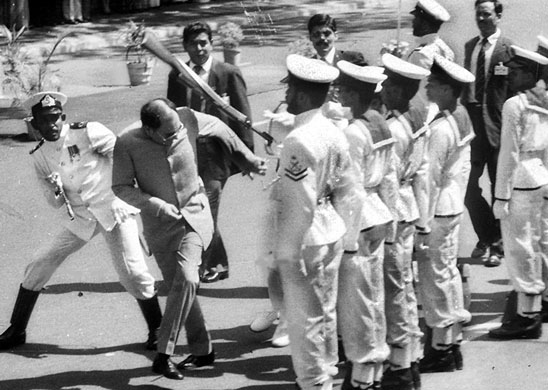 Naval Rating Vijitha Rohana Wijemuni attacking Indian Prime Minister Rajiv Gandhi with his rifle butt when the PM was inspecting the Guard of Honour, before his departure
Naval Rating Vijitha Rohana Wijemuni attacking Indian Prime Minister Rajiv Gandhi with his rifle butt when the PM was inspecting the Guard of Honour, before his departure
By 11.30 a.m. that day (July 28, 1987) all roads in and around Fort area were blocked since nearly 20,000 people had gathered near the Bo-Tree junction. Seth pirith chanting was heard. People panicked when the police baton charged after tear gassing the crowd. There was repeated gunfire. Ten procesions, each comprising over a thousand people marched in four different directions. The protestors setfire to buses and other state property, sending clouds of black smoke int the air.
The first to be shot dead in the anti-accord protest was Moratuwa University Engineering Student Clifford Perera. This writer identified the body and sent a message to his father who was employed at Millers Limited Colombo. A total of 21 persons died as a result of shooting at the same spot. People in the vicinity took the dead and the injured to hospital. The violence which started near the Bo-tree junction quickly spread all over the island. According to official Government estimates 132 protesters were killed and 712 persons including 56 bhikkus were taken into custody during five days from July 27 to August 2. The number of violent incidents was 2,527. An anti-accord group (suspected to be DJV) shot dead Tangalle’s UNP MP Jinadasa Weerasinghe on August 1, 1987.
In addition to President Jayewardene, Minister Gamini Dissanayake too played a key role in connection with the Indo-Lanka Accord. Prime Minister Premadasa and Minister Athulathmudali expressed their silent disapproval of it. Indian PM Rajiv Gandhi and wife Sonia Gandhi arrived in Sri Lanka on July 29, 1987 at 10.30 a.m. From Katunayake they travelled by helicopter to Galle Face.
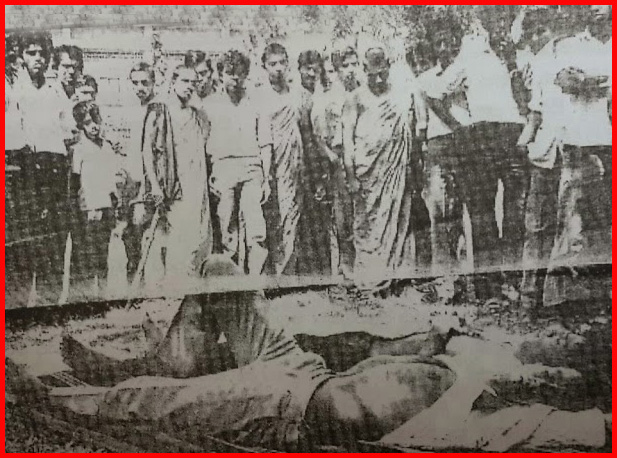 University students standing near the bodies of two fellow students killed during the protest against the Indo-Lanka Accord.
University students standing near the bodies of two fellow students killed during the protest against the Indo-Lanka Accord.
On the same day at 11.30 a.m. unofficial talks were begun between President Jayewardene and the Indian PM. Three discussions were held till midnight and the final talks were held on the morning of July 30. Defying the curfew hundreds and thousands of people were demonstrating against the accord, which was signed on July 29, 1987 at 3.37 p.m. On the same day, Cabinet Minister Gamini Jayasuriya resigned from the Government in protest against the accord. MP Mahinda Yapa Abeywardena did not vote for the Provincial Council Bill when it came up in Parliament following the accord.
Before Rajiv Gandhi’s departure a Naval Guard of Honour was held opposite the President’s House, Fort. Prime Minster Premadasa and Minister Athulathmudali boycotted the ceremony which began on July 30 at 9.30 a.m. As the Indian PM escorted by a Sri Lankan Navy Officer Lieutenant Mendis was inspecting the Guard of Honour one its members Leading Rate Wijemuni Vijitha Rohana attacked Rajiv Gandhi with his rifle butt. Although the PM ducked to avoid the blow it struck his shoulder but with no serious injuries. The only cameraman who was able to photographically record the incident was Sena Vidanagama of Lake House. This writer was among the media personnel who were present there to report the Guard of Honour. Rajiv Gandhi as scheduled left for Delhi from Katunayake on the same day at 11.30 a.m.
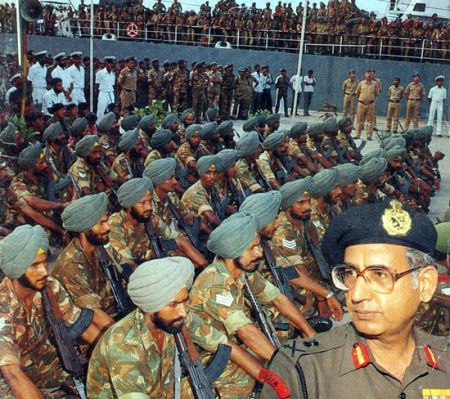 The last unit of the Indian Army leaving for India from Trincomalee on March 24, 1990
The last unit of the Indian Army leaving for India from Trincomalee on March 24, 1990
Wijemuni Vijitha Rohana, born in Boossa, Ratgama, was 22-years-old at the time. He told the Court-Martial that he had no intention of killing the Indian PM but only did so to disgrace him internationally for intimidating Sri Lanka and using force on the country to impose the accord. Attorneys including Stanley Tillekeratne, Donald Hewagama, Susil Premajayantha appeared voluntarily for Wijemuni who was sentenced to six years rigorous imprisonment by the Court- Martial for attempted culpable homicide not amounting to murder. Later he was pardoned and released on April 3, 1990.
Even before the Indian PM‘s departure, Indian troops – the so-called Indian Peace Keeping Force (IPKF) – had established themselves in Sri Lanka’s Northern and Eastern Provinces by the afternoon of July 29, 1987. Nearly 100,000 Indian soldiers landed in the island during this period. The number of Indian military personnel including officers killed during the anti-LTTE operations in the North and East was around 1,500. About 8,000 Tamil separatist terrorists and others were killed by the Indian troops. This resulted in IPKF being branded the ‘Indian People Killing Force.’ Evacuating them from Sri Lanka began from the Ampara District on October 25, 1989. The last Indian Army unit left for India from Trincomalee on March 13, 1990.
The Indo-Lanka Accord, the 13th Amendment and Provincial Councils are links in a single chain. The Provincial Council system which has been called a white elephant was born out of the Indo-Lanka Accord which introduced the 13th Amendment. The aim of the second JVP insurgency was to oppose the accord which India forced on Sri Lanka. The insurgency claimed the lives of 41,813 people.
Following the Accord’s failure to end the Tamil separatist struggle Prime Minster Ranil Wicktremesinghe of the UNP Government which came to power in 2002 signed a ceasefire agreement with Prabhakaran via the Norwegian Government. That too was a failure. Eventually it was President Mahinda Rajapaksa who won the war by totally defeating the LTTE on May 18, 2009.(The writer is a senior journalist who could be reached at ejournalists@gmail.com)
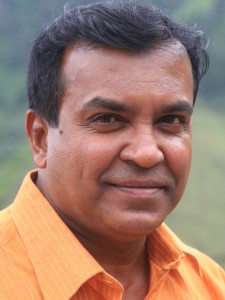
July 28th, 2015 at 7:37 am
By Dharman Wickremaratne- Well written !
July 28th, 2015 at 11:02 am
The Tamil Nadu based New Indian Express (NIE) may dismiss our fears of the Tiger Nominated Party’s platform as a “MERE SPIN” on advocacy of separatism … BUT WE KNOW BETTER!
Years of Anti-National UNDERMINING of our Motherland by the TNA in collusion with SEPARATISTS, the Tamil Diaspora, COMMUNAL Tamil Nadu Politicians attempting to EXPAND DRAVIDA NADU, and NeoColonialist Foreign Powers Iintent on recreating Sri Lanka in THEIR IMAGE, LEAVE US IN NO DOUBT that this iss the THICK END of the WEDGE to achieve their Mono-Ethnic Apartheid SEPARATIST Bantustan of EELAM in Sri Lanka!
NO DOUBT WHATSOEVER!
……………………
Rajapaksa-led UPFA Sees Eelam Spin in TNA Manifesto
July 28 (NIE) COLOMBO- The manifesto of the Tamil National Alliance (TNA) for the August 17 Sri Lankan parliamentary elections has become a major issue among the Sinhalese majority in the island nation.
The TNA’s demand for “self-determination within a united but federal Sri Lanka” is being interpreted as a stepping stone to an independent Tamil Eelam. The TNA wants the 13th Amendment of the Lankan constitution to be scrapped and replaced by an amendment ensuring a federal structure with greater devolution of power to the provinces
Parties aligned with the United Peoples’ Freedom Alliance (UPFA) led by former President Mahinda Rajapaksa are not only voicing fears of Tamil separatism but asking the Sinhalese parties friendly to the TNA, to explain their stand on the manifesto.
UPFA candidate Tissa Attanayake dubbed the TNA manifesto as a “national security threat.” The UPFA is trying to taint the United National Party (UNP)-led United National Front for Good Governance (UNFGG) as an “anti-national” combine which should be shown the door. The UPFA hopes that the TNA manifesto will enable it to strengthen its hold on the Sinhalese-Buddhist community, which had supported it strongly in the January 8 Presidential elections.
The high voltage UPFA campaign forced Prime Minister and UNP leader Ranil Wickremesinghe, to declare that his party is for “devolution of power to the provinces within a unitary constitution and not a federal constitution.”
Another controversial aspect of the TNA’s manifesto is its demand for the re-unification of the Tamil-speaking Northern and Eastern Provinces to form a single North-Eastern Province as per the Indo-Lanka Accord of July 1987. The Muslim parties are dismayed by this because the Muslims will become an insignificant minority in a unified North-Eastern province. The Muslims are in substantial numbers in the Eastern Province. So far, two of the three Chief Ministers of the East have been Muslims.
If the UNFGG does not clarify its stand on the merger issue, a section of the Muslims in the East could vote for the UPFA which had detached the North and East by securing a Supreme Court order in 2006.
TNA’s spokesman, Suresh Premachandran said that the party’s manifesto did not say anything that it had not said in its earlier manifestos.
July 28th, 2015 at 12:43 pm
දොළොස් වැදෑරුම්
ප්රතිපත්ති මාලාවකින් යුත් එජනිස ප්රතිපත්ති ප්රකාශය එළිදකී
Divaina – 28/7/15
අනුර බාලසූරිය
සම්ප්රදායික දේශපාලන පොරොන්දු මාලාවකින් ඔබ්බට ගිය බුද්ධිමත් කථිකාවක ප්රතිඵලයක් වශයෙන් සකස් කරන ලද එක්සත් ජනතා නිදහස් සන්ධානයේ “අනාගතයට සහතිකයක්” නම් වූ නව ප්රතිපත්ති ප්රකාශය ඊයේ (28 දා) පෙරවරුවේදී කොළඹ හෙන්රි පේද්රිස් උද්යානයේදී මහත් උත්සවාකාරයෙන් එළිදක්වනු ලැබීය.
ශ්රී ලංකාවේ පිළිගත් වියතුන් විශාල පිරිසකගේ උපදෙස් පරිදි අදාළ ක්ෂේත්රයන් පිළිබඳ හසල අත්දැකීම් සහිත ප්රවීණයන්ගේ මාර්ගෝපදේශකත්වයෙන් මෙම ප්රතිපත්ති ප්රකාශය සකස් කර ඇත.
දිවිහිමියෙන් රැකගෙන ආ මව්බිමේ අභිමානය, ඒකීයත්වය, භෞමික අඛණ්ඩතාව දිවිහිමියෙන් සුරකිමින් රට ඉදිරියට ගෙනයැමට කැපවන බවට ද එමගින් පොරොන්දු වී ඇත.
මෙම ප්රතිපත්ති ප්රකාශය ප්රථමයෙන් මහා සංඝරත්නය වෙනුවෙන් දක්ෂිණ ලංකාවේ ප්රධාන සංඝනායක පල්ලත්තර සුමනජෝති නාහිමිපාණන්ට හා කැලණිය විශ්වවිද්යාලයේ කුලපති ආචාර්ය වැලමිටියාවේ කුසලධම්ම නාහිමිපාණන් වහන්සේ වෙත හිටපු ජනාධිපති මහින්ද රාජක්ෂ මහතා විසින් පිළිගන්වන ලදී.
සන්ධානයේ මහ ලේකම් සුසිල් ප්රේමජයන්ත මහතා විසින් හිටපු ජනාධිපති මහින්ද රාජපක්ෂ මහතා වෙත එම ප්රකාශය පිළිගැන්වීමෙන් අනතුරුව මහා සංඝරත්නය වෙත ද හින්දු, ඉස්ලාම්, ක්රිස්තියානි පූජකතුමන්ලා වෙත ද සන්ධානයට අයත් පක්ෂ නායකයන්, නියෝජිතයන් ඇතුළු පැමිණ සිටි ආරාධිතයන් වෙත ද පිළිගන්වනු ලැබිණි.
අදීන ජාතියක්, නවීන දේශයක්, සුහද සමාජයක් සඳහා දොළොස් වැදැරුම් ප්රතිපත්ති මාලාවකින් යුත් ජාතික ඒකාග්රතාව සහ තිරසාර සංහිඳියාව, දූෂණය පිටුදැකීම සහ අධිකරණයේ ස්වාධිපත්යය සුරැකීම, ආර්ථික කළමනාකරණ, විදේශ, නිවාස සහ ඉඩම්, අධ්යාපන, සෞඛ්ය, පරිසර හා වනජීවී, සංස්කෘතික කලා සහ සන්නිවේදන කටයුතු ප්රවර්ධන, ක්රීඩා සහ තරුණ කටයුතු, කාන්තා හා ළමා, ආයෝජන හා යටිතල පහසුකම්, ප්රවර්ධන යන අංශ කෙරෙහි විශේෂ අවධානය යොමුකර ඇත.
මෙම ප්රතිපත්ති ප්රකාශයේ සඳහන් කරුණු අනිවාර්යයෙන්ම නියමිත කාලසීමාවක් තුළ ක්රියාත්මක කරුණුවලින් යුත් ප්රායෝගික වැඩපිළිවෙළක් බවත් කඩිනම් වැඩසටහන සන්ධාන රජය පත්වී දින 30 ක් ඇතුළත අරඹන බවත් එහි සඳහන් කර තිබේ.
මෙම ප්රතිපත්ති ප්රකාශය එළිදැක්වීමේ අවස්ථාවට හිටපු අග්රාමාත්යවරයකු වූ රත්නසිරි වික්රමනාක, පක්ෂ නායකයන් වන දිනේෂ් ගුණවර්ධන, වාසුදේව නානායක්කාර, විමල් වීරවංශ ඇතුළු සන්ධානයට අයත් දේශපාලන පක්ෂ 15 ක නායකයෝ ඇතුළු හිටපු සන්ධාන මන්ත්රීවරු පිරිසක් එක්වූහ.
July 28th, 2015 at 9:12 pm
Ananda USA I ask this Dhamaya what relevance has todays situation got to do with what happened 28 years ago? Dharmaya, You think average person doesn’t know what you are attempting to do! Deviate focuses away from the Election issues. Like MR talking to Muslim supporters. Dhramaya gets big money in Dollars for this article.
SA Kumar, Ask Dhamaya who pays for this article? Answer RANIL PUNKS OFFICE
July 29th, 2015 at 4:57 am
SA Kumar, Ask Dhamaya who pays for this article? Answer RANIL PUNKS OFFICE – My Sinhala Sakothara(m) be cool !
Andupdan…
(I)lanka(i) Putha(lvan) !!!
July 30th, 2015 at 5:00 am
I think Lankaputhra has got his wires crossed. This has EVERYTHING to do with election issues. Anyone with common sense can see this article is NOT in favour of Ranil but has the very opposite effect. When the UNP-led alliance and CBK is relentlessly focusing on alleged and actual misdeeds committed under MR during his 10-year rule, it is natural that the latter’s supporters have gone to an even earlier period and drawn attention to the way the UNP regime (in which Ranil was a cabinet minister) messed up things in the 1980s. The article shows (1) how the Jayewardene Government capitulated in the face of Indian intimidation and caused a chain of events which eventually led to a massive bloodbath and (2) how the UNP and JVP which engaged in tit for tat killings then are now behaving as they were paragons of virtue, seeing only the ills of MR.
July 31st, 2015 at 5:44 am
Yes samurai !! Lankaputhra is always going at a tangent in this forum. Gibberish is the word.